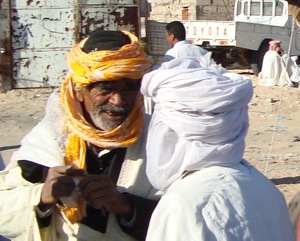Is it the result of a breezy disposition or is it the natural Anglo-Saxon discretion of a professor at the University of Edinburgh? The morning we meet, it is as much as he can do to admit that he still has a few small jobs to finish before the fateful day.
To listen to Richard Thomson, everything is being carried out without a hitch and on good terms with the French curators who are helping him. The catalogue? The entries were submitted on time and they are of good quality. The design of the exhibition space? He is relying on the ideas of Hubert Le Gall, with whom plain-speaking is the rule. The hanging of the pictures? The plan was fixed long ago using computer simulations.
Calculated to the nearest tenth of an inch
On this point, however, Mr Thomson admits that his happiness is not complete. He yearns for the time when hanging was not calculated to the nearest tenth of an inch weeks before the arrival of the paintings, when the curator and a few assistants positioned the canvases "by eye", taking them from room to room until the desired effect was achieved. "That's impossible today. Can you imagine, with the cost of insurance? They would think that we were being irresponsible". Each Monet, then, already has its spot reserved.
This is even more the case because the exhibition has been designed to follow a very complex structure: "That's the key feature of my work: to think about the best way of showing a painting, not settling for an ordinary, boring retrospective where the masterpieces come one after another in chronological order from beginning to end. It has been about giving a new image of Monet, about sparking off new debates".
And so begins Thomson's account of how he first thought about the history of the exhibition: "I thought that 1890 should be the pivotal date. Monet was 50 in 1890. He arrives at Giverny. The art dealers are becoming more and more interested in him. And it's the start of his series. There is a before and an after 1890. That's the central idea. The first section comprises French landscapes before this date, the links between their creation and nature: the canvases from Fontainebleau, Normandy, the region around Paris, Vétheuil and two places further away, Belle Ile and the Creuse region. At the end of this part, I wanted a very clear break. There will be two rooms, one devoted to the human form in the years 1870 and 1880, the other to still-lifes. I preferred to do that - rather than scatter figures and still-lifes everywhere - to show that, for Monet, these are important subjects. Then the second section, the years after 1890, begins".
You only need to hear the historian's voice to sense how important it is for him to convince the listener of the appropriateness of his scheme. His explanation is already well-polished. There will be, then, another three subjects, with the themes of repetition, inner nature and adornment. Haystacks and Poplars will appear in the first, Vétheuil and Venice in the second, Giverny and her water-lilies in the last.
Once the order was established, all that remained was the paintings themselves. Everything went well, perhaps even too well. "At the end of 2009, the museums started to reply. All the responses were positive.. In fact, there were too many paintings. Towards Christmas, we knew that we were going to have to make some sacrifices. I had started with the idea of 200 paintings but it became clear that we'd have to go down to 175 so that there would be enough space left for visitors". But how does he explain so many loans? "The American museums have been very forthcoming... New York, Boston... They're used to working with the Orsay and that helped with the negotiations".
No setbacks, then? "Unfortunately, yes. The Marmottan Museum refused to lend, Impression, Rising Sun", the historic work to which Impressionism owes its name. "But it's not too serious. They will be some less well-known paintings whose discovery will to a large extent compensate for its absence. We suggested some exchanges but, clearly, it wasn't possible. In its place you will see a view of the port of Le Havre from 1873, a night scene, an extraordinary one, that has come from a private collection".
Having worked so long on Monet, what has he learned? "That you have actually to go to the places where he painted to be able to understand him". So the museum man got lost in a forest in the Creuse: "I wanted to find the spot where Monet had painted the confluence of two rivers in 1889 - he painted it ten times. Today, there are trees everywhere. I couldn't see the river any longer. Nothing corresponded to the paintings. Monet had gone there at a time when the peasants had stripped the wood for heating and when their herds of goats were grazing on the under-growth. The hills were bare. Today, it's a forest. I finished by finding my bearings thanks to a rock... I started again at Belle Ile so that I could identify the exact viewpoint over the needles of Port Coton. Just at the edge of the cliff, about 50 yards away. That's what organising a Monet exhibition drives you to!"
This article first appeared in Le Monde, August 17 2010; it was translated from the French by Culturissima's managing director, Dr David Winter.
This article first appeared in Le Monde, August 17 2010; it was translated from the French by Culturissima's managing director, Dr David Winter.



